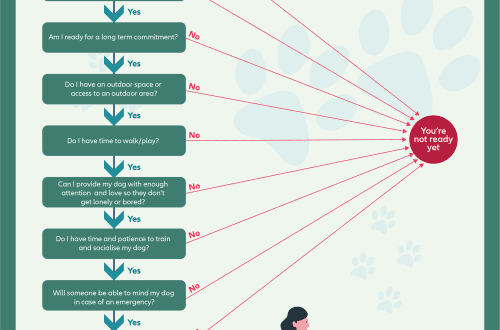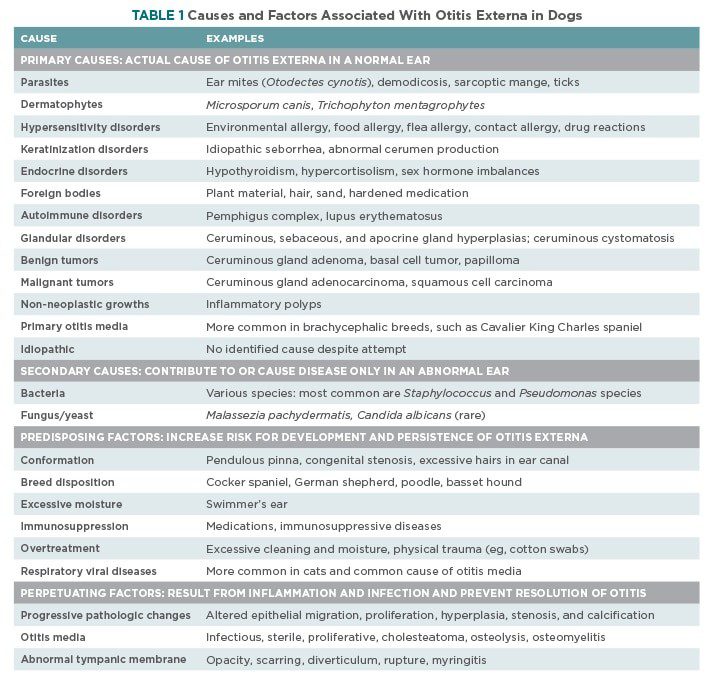
Otitis in dogs – causes, symptoms, types, treatment
Contents
- Why does otitis media develop in dogs?
- Photo of otitis media in dogs
- How does otitis media present in dogs?
- Types of otitis media in dogs
- How to diagnose
- Treatment of otitis media in dogs
- Drugs for the treatment of otitis media in dogs
- Complications of otitis media in dogs
- Features of treatment at home
- What to do before visiting the vet
- Prevention of otitis media in dogs
Why does otitis media develop in dogs?
There are a number of major causes of otitis media in dogs.
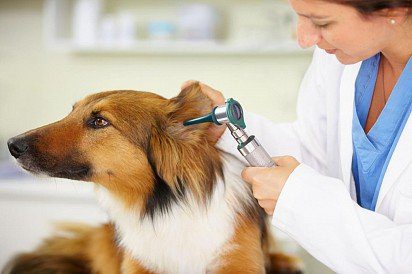
Regular cleaning of the ears is the best prevention of otitis
- Decreased immunity. The low activity of the pet’s immune system leads to a weakening of the protective function of the skin. As a result, in the ears there is an increased reproduction of numerous microorganisms and fungus, inflammation develops.
- The presence of hair in the ears. Too thick hair in the dog’s ears has several negative effects: it interferes with the removal of excess sulfur from the ear canal, blocks the access of air (it stagnates and becomes waterlogged), irritates the skin, leading to increased work of the ear glands.
- Neoplasms in the ear. The growths in the ear canal can disrupt ventilation, bleed, fester, causing an active growth in the number of pathogenic microbes.
- Allergy. Allergic reactions cause otitis by increased sulfur secretion, a decrease in local immunity.
- Ear mite. Damages the skin of the ear canal, causing inflammation.
- Growth of cartilage and skin folds. This feature is typical for dogs of certain breeds, for example, sharpei. As a result of an excessive increase in the size of the folds in the ear canal, gas exchange is disturbed in it.
- Water penetration. Stagnation of fluid in the ear contributes to the reproduction of pathogenic microorganisms.
- Entry of a foreign body. If a foreign object gets stuck in the dog’s ear, air will stop, irritation of the nerve endings will begin, the release of sulfur in excess, and the growth of bacteria.
- Hormonal disbalance. Any endocrine disorders can cause excessive secretion of sulfur, a decrease in local defenses.
- Wrong nutrition. An excess of simple sugars (sweets) in the pet’s diet leads to their presence in the produced sulfur. Released in an increased volume, it becomes a breeding ground for infection.
- Heredity. Animals with drooping ears (spaniels), an overly open shell (shepherd dogs) and those prone to allergies are more likely to develop otitis media than others.
Photo of otitis media in dogs
How does otitis media present in dogs?
Symptoms of otitis media in a dog can be varied, the degree and form of their severity depends on the type of disease, immunity, individual characteristics of the pet, neglect of the process. The owner should contact the clinic if he notices the following manifestations:
- the animal shakes its head or scratches its ears frequently;
- the pet does not allow you to touch the ears;
- there was a discharge from the external auditory canal;
- the dog whines when he tries to scratch his ears;
- too much sulfur in the passage;
- wool falls out at the beginning of the ear canal, sores, redness, wounds appear;
- lymph nodes under the jaw of the animal are enlarged;
- the ears are hot to the touch, and their swelling is observed.
As the pathological process develops, the general body temperature of the pet rises, he refuses to eat.
In some cases, the predominance of one or another symptom may indicate the cause of otitis media.
Ear mite
On the surface of the skin of the auricle and ear canal there are dark crusts. When they are removed, wounds can be distinguished
Bacteria, fungi
Swelling of the skin, redness, suppuration, increase in local and general temperature
Water
Liquid discharge from the ears
Allergy
The appearance of an allergic reaction in other parts of the body
Types of otitis media in dogs
There are several classifications of otitis media in dogs.
By origin
- Primary. It develops independently (hypothermia).
- Secondary. It is a consequence of any disorders, for example, hormonal.
By localization
- External otitis.
- Otitis media.
- Internal otitis. The most dangerous, as the eardrum, cartilage tissue become inflamed. There is a threat of sepsis and the spread of the process to the brain.
By the nature of the discharge
- Purulent.
- Exudative (a lot of sulfur is released).
With the flow
- Spicy. It is characterized by severe pain, a sharp development of symptoms.
- Chronic otitis. Has washed out symptoms. It is characterized by a long course with alternating periods of exacerbation and remission.
According to the source of inflammation
- Fungal. The reproduction of the fungus is very intensive, so the disease quickly passes to the inner ear. Symptoms are pronounced, which brings anxiety and pain to the pet.
- Bacterial. Accompanied by an increase in temperature, the formation of crusts on the surface of the ear canal.
- Malasession otitis. Refers to fungal types of otitis media. The causative agent is Malassezia. It is present on the surface of the skin of the dog’s ear, but manifests itself only when the body’s defenses are reduced. Often accompanied by a bacterial infection.
- Allergic. Manifested in swelling, itching, redness of tissues. Does not respond to antifungal and antibacterial drugs. You can suspect an allergy if you find similar symptoms in other parts of the body.
- Verrucous otitis media (warty). Numerous warts, growths form on the surface of the dog’s ear skin, which gradually block the ear canal, leading to inflammation.
Important: to diagnose the type of otitis in a dog, it is better to consult a specialist. Only laboratory tests can accurately indicate the cause of the disease. Self-selection of drugs can provoke complications, up to deafness or inflammation of the meninges and death of the pet.
How to diagnose
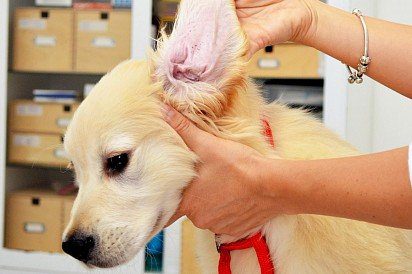
Veterinarian examination
In the veterinary clinic, the owner will not only need to show the dog to a specialist, but also answer a number of questions. Of great importance for the diagnosis are: diet (the predominant product or feed), walking characteristics, the presence or absence of vaccinations, chronic diseases. You will need to remember when the symptoms appeared, what is the nature of the disease, the behavior of the animal and other nuances.
For diagnosis, a veterinarian may prescribe the following types of examinations:
- blood tests, discharge from the ear canal;
- ear scraping;
- x-ray (if a foreign object is suspected);
- tomography (to assess the condition of the inner ear, meninges).
Treatment of otitis media in dogs
Treatment of otitis media in dogs is complex. The conservative approach includes a number of areas:
- elimination of the cause (if possible);
- removal of puffiness, itching, pain;
- getting rid of crusts, secretions, external treatment;
- detoxification of the pet’s body;
- destruction of pathogenic microbes in the ear and throughout the body;
- strengthening the immune system.
If we are talking about the overgrowth of the ear canal, tumors, foreign body, then it is possible to carry out surgical intervention.
Due to the variety of forms of ear inflammation in dogs, treatment will vary. So, in chronic otitis media, in addition to antibacterial drugs prescribed during an exacerbation, it is recommended to use drops to prevent the growth of fungi and bacteria. Fungal otitis requires the use of antimycotic agents, and bacterial inflammation is treated with antibiotics. When diagnosing allergic otitis, first of all, a strict diet and antihistamines are prescribed.
Drugs for the treatment of otitis media in dogs
In the treatment of otitis media in dogs, the following drugs have successfully proven themselves.
Appointment of the drug
Medicine name
Hygiene treatment
Otoklin, Otifri
Antiseptics
Hydrogen peroxide, Chlorhexidine
Healing
Sanatol, Levomekol
Eliminating the symptoms of inflammation (pain, itching)
Otinum, Otipax
Antimicrobial drops
Otobiovet, Sofradex, Tsypromed
Antifungal
Clotrimazole, Nitrofungin
From ear mites
Amitrazine, Leopard, Otoferonol
Antibacterial
Amoxicillin, Ceftriaxone, Mastiet forte
Combined
Otospectrin, Tresaderm, Oricin
Detoxification of the body
Hydrolysin, Sirepar
To improve immunity
Immunofan, Cycloferon
Complications of otitis media in dogs
An untimely appeal to a veterinarian or a sharp and rapid development of an infection can lead to dangerous complications, which is especially characteristic of bacterial otitis media. In addition to the transition of the disease to a chronic form, the dog may have such consequences as:
- hearing loss, deafness;
- inflammation of the meninges;
- neurological disorders;
- psychical deviations;
- swelling of the inner ear;
- lesions of the eyes of a purulent nature, strabismus.
Features of treatment at home
Even if the owner knows how to treat this or that type of otitis in a dog, it is necessary to carry out ear therapy at home only after identifying the pathogen. You should not immediately stuff your pet with antibiotics or bury the first drops that come to hand. Such “treatment” can lead to a deterioration in the condition of the animal.
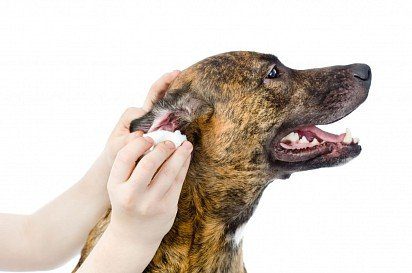
Treatment of otitis in a dog at home
What other rules should be observed when treating an animal at home? First, ear cleaning should be done with a swab, not a stick. Due to its small size, it is impossible to fully hygiene the auricle and ear canal.
The owner must have the skills to clean the ears of the animal, especially if the breed has a tortuous ear canal, there are numerous folds and cartilage growths. There is a high probability of inept actions to cause pain in the dog. In addition, if there are outgrowths and folds, it will not be possible to properly see the surface of the skin and carry out hygiene.
Some owners believe that hydrogen peroxide should be instilled into the animal’s ear so that it “dissolves” deposits, which can then be easily removed. In fact, the solution is intended only for treating the sink. Penetrating into the ear and contacting with pus, damaged surface, gray, peroxide foams, leading to specific sounds in the ears. The animal may be afraid.
All that is required from the owner is to provide the dog with peace, adequate competent treatment, good nutrition and attention.
What to do before visiting the vet
If you can’t immediately seek help from a veterinarian, you can take several independent measures that will ease the condition of the dog.
- Examine the concha and external auditory canal. This must be done carefully so as not to hurt the animal.
- In the presence of damage, treat them with a swab dipped in hydrogen peroxide.
- Otinum can be dripped inside the ear. This remedy is not dangerous for the health of the dog. It will help eliminate pain, itching, soften deposits. It is better not to use other drops or ear ointment before a doctor’s examination and diagnosis, so as not to accidentally contribute to the resistance of microorganisms to further treatment.
- If your pet is feverish, you can give him an antipyretic, such as paracetamol.
May your dog’s ears be healthy!
Prevention of otitis media in dogs
Minor restrictions and rules for caring for a dog will help prevent the development of otitis media.
- The better the immunity, the less susceptible the dog to infections and parasites. A full diet and walks will help strengthen the body’s defenses.
- Regular cleaning of the ear shells 1-2 times in 7-10 days is shown not only as a hygienic procedure, but also as a preventive one (detection of the disease at an early stage).
- Avoid hypothermia of the animal.
- After water procedures (at home or in a pond), excess water should be removed by blotting the ear with a swab, tilting the dog’s head to one side.
- It is undesirable to let your pet go outside alone. The animal can get hurt, as well as “get acquainted” with other dogs infected with ear mites, fungal or other infections.
An attentive attitude to a four-legged friend and, in case of otitis media, a timely visit to the veterinary clinic will be the key to the health of the ears and the whole body of the dog.





